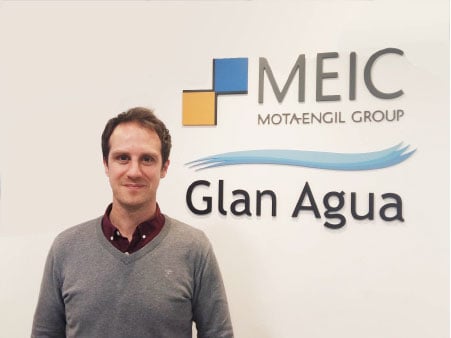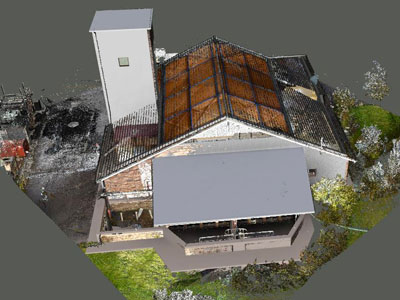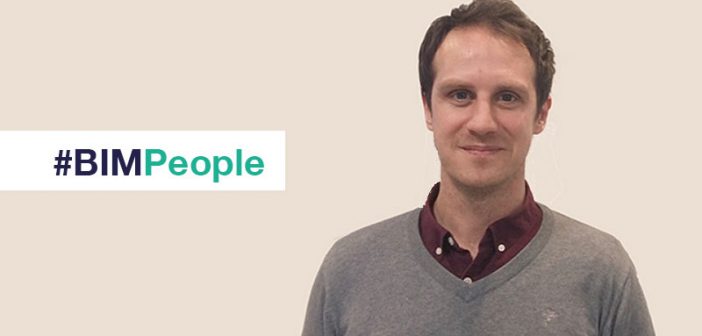Jonathan Grimes, BIM Implementation Manager at Glan Agua Ltd, talks about using BIM on projects, applying what he has learned from his DIT MSc degree to the work environment and what BIM can bring to projects.
Glan Agua Ltd provide project solutions for the water and wastewater industry including design, construction, commissioning, operation and maintenance. Glan Agua Ltd is part of Mota-Engil Europe S.A. within the larger group of Mota-Engil SGPS, Portugal’s leading Engineering and Construction service providers. Undertaking many projects using BIM, Glan Agua’s Kerry Regional Water Supply Scheme (KRWSS) was a finalist in the BIM Excellence category at the 2018 Irish Construction Excellence Awards. Here Jonathan tells us more.
Can you tell us about your work as BIM Implementation Manager at Glan Agua Ltd and your duties?

Making sure we have correctly defined our BIM capability on tenders is essential to seeing that our return on investment is maximised while also assuring our clients that Glan Agua’s primary aim is to always provide the best turnkey solution to their requirements.
I assess the workflows and processes for contracts awarded, define the set-up of the CDE, specify the project naming convention and plan the BIM deliverable approach. Glan Agua place an emphasis on incorporating innovative solutions which can drive greater efficiency on upcoming projects and improve our design, delivery or handover process. This methodology warranted the use of Dynamo to populate client asset registers directly from our model authoring software on recent projects.
Can you tell us about the main projects that you have worked on and have utilised BIM on?
Since the implementation of BIM by Glan Agua, a number of projects have been completed to varying levels of BIM adoption. We made the conscious decision as a company to develop our BIM process incrementally over time on projects. Apart from the KRWSS, which was the first project we received a definitive BIM requirement in the tender documents, we have been using a BIM approach for the last number of years on our larger projects.
Our initial foray into the BIM space was on the North East Roscommon project. This project allowed us to get our modelling processes in place. It was an essential step toward where we currently are today. After Roscommon, the focus progressed from modelling procedures to implementing BIM process and workflows into our delivery methodology.
In more recent times, we have completed a number of projects in the pharma, water and waste water sectors using BIM-based methodologies from the outset. The fact that we chose to continually implement BIM on projects in Ireland without direction from our clients put us in a strong position to hit the ground running as we started to win work in the UK, where the “will we” “won’t we” was not up for discussion.
Our QA/QC procedures allow us to continually develop our methodology on a project by project basis. Through an iterative process of evaluation, we try to improve on what has worked and understand why other procedures didn’t quite have the desired outcome. This approach has allowed us to, over time, develop BIM procedures which are tailored to our clients and the sectors in which they operate.
What has been the outstanding project from these and how did BIM deliver value to the client and help the design team and contractor deliver the project?

We developed a range of Dynamo scripts to directly populate the client asset register, the information contained in the model was obtained by bespoke templates issued to the supply chain. The scale of the project meant a large portion of our organisation received first-hand knowledge of working on a BIM project.
As a result of employing BIM we were able to deliver the project on time, on budget and to an extremely high level of quality. Additionally, working closely with the client’s representative, Nicholas O’Dwyer, and with Irish Water themselves throughout the project allowed us to incorporate solutions to many of their asset management procedures which will pay dividends over the lifecycle of the plant.
Can you tell us more about the Kerry Regional Water Supply Scheme for Irish Water?
This was a Design, Build and Operate (DBO) Contract being delivered using the FIDIC Gold form of Contract. The design, both at tender and contract award stage, was the sole responsibility of Glan Agua. Glan Agua were appointed as the successful contractor and commenced works in April 2016. The project brief was the construction of a 51,000,000 litres per day facility; the key BIM deliverable was a 6D BIM model compatible with the client’s FM system.

There was a client requirement to have data-rich models developed from the earliest possible stage in the project which could be integrated to their chosen FM system. These requirements were initially defined in the Project Tender documents by the client. A project-specific BIM Execution Plan was issued to the client in the early design phase of the project. This BEP detailed what the perceived client requirements were as we interpreted them. Once these were agreed with the client, the project BEP became a live developing document throughout the course of the project lifecycle. The means of measurement used to quantify the delivery of the client data was verified at various stages through exporting data directly from the model which was compared against the specifications set out in the tender documentation.
The primary BIM goal was to create an asset rich Information model. This allowed extraction of data from the authoring software which was directly compatible with the prospective client FM application. We welcomed the challenge and developed a number of bespoke solutions to achieve an end product which gave the client exactly what they wanted from the process. In this regard, we were very fortunate to be working with Irish Water and their client representatives on the project, Nicholas O’Dwyer. I think we all developed an understanding from early in the project of the benefits that could be achieved for all involved using BIM.
Have Glan Agua won work in the UK based on BIM capabilities?
Yes, we have gradually been tendering and successfully awarded larger projects in the UK based on our ability to deliver exactly what our clients are looking for. Having the BIM capabilities, what we possess in-house is definitely a decisive factor. Although I feel it is probably the combination of our organisation’s ability to deliver the most innovative turnkey solutions, of which BIM is a key aspect, which has won us the work.
We are currently developing a detailed BIM project with a UK client which will be a further step for our company on our BIM journey.
What is your advice to utility providers with regards requiring BIM on projects?
In my opinion and from our company perspective, and I think it will happen much more frequently as BIM awareness continues to grow, it would be to ask for BIM and define your requirements early. There is a lot of BIM expertise in Ireland and I feel that, from the perspective of utility companies, once they get their BIM documents defined, they can get more and more from the companies they work with.
I think the change in understanding of BIM from being a purely 3D design tool to an overall delivery process is a key factor to the growing interest from utility providers. It is still relatively early in terms of adoption but now that the questions are being asked- and more importantly, answered, it will become more common for utility providers to receive and benefit from BIM.
I think the sooner BIM processes are considered business as usual, the better it will be for clients and in particular their asset management functions.
Tell us about the MSc in applied Building Information Modelling & Management at DIT?
The MSc in Dublin Institute of Technology is a top-class programme. I really couldn’t fault it; the course is set up in a way that the first year gives you the opportunity to investigate the BIM standards and how they can be applied. The programme really allows you to take this information and apply it in a collaborative environment just as it should apply in the real world, in an environment which allows mistakes to be made (without the financial or legal implications).
The lecturers and guest lecturers couldn’t do enough to give advice and the other participants on the course have a really in-depth knowledge of what BIM means to their disciplines. I think they have taken the right approach and are currently delivering the most advanced academic BIM programme in the country. I initially undertook the first year of the MSc programme in 2015 and learning from the likes of Barry McAuley, Trevor Woods and Avril Behan was a great foundation. After a few years of working in the “BIM” bad world, I returned last September and I was amazed by the level of BIM knowledge of the course participants. We have had Kevin Furlong for much of the second year and I think his drive has really given us all a greater understanding of Building Information Modelling and Management delivery.
I think in the intervening while I was away, they have used industry feedback extremely well and are now producing course graduates who can provide real benefit to their employers.
What were the main skills you learned from this course and applied in your work?
It’s hard to compress everything I have picked up on the MSc programme and like most of academia, you get out what you put in. I would definitely consider the academic writing we have to produce on BIM standards and workflows to be hugely beneficial to developing an understanding of how BIM can be applied to a variety of projects. Understanding the process and the workflows needed to deliver BIM is essential, so the investigative aspect of the course has been a massive benefit to me professionally.
From a technical aspect, I would say getting an introduction to software such as Dynamo, IES and CostX would probably not have happened as quickly, due to my day to day duties, had it not been for the MSc in DIT.
Does the education and training in Ireland give contractors an advantage when competing for work internationally?
Yes, definitely. I think the Irish construction sector is extremely adaptable to change. I think we are very efficient when it comes to realising where the industry trends are heading. Obviously, the availability of training, combined with an understanding by companies of the benefits of training their staff, means we can offer genuine expertise and the ability to deliver. I think that, although we have not had a BIM mandate yet, we are most definitely in line with our near neighbours when it comes to BIM knowledge, expertise and ability to deliver.
How do you see BIM changing the utilities sector?
I think BIM can only bring positive change to most sectors of the construction industry but in the utilities sector, I think BIM can bring massive benefits to cost certainty, lifecycle analysis and asset management. I firmly believe that, with advancement in IOT technologies, these changes will also bring additional benefits to monitoring of systems and predictive forecasting.
Will BIM change public sector project delivery?
I think BIM will change public sector project delivery. in my opinion, the early contractor involvement approach and shared risk and reward type of procurement route will become more and more prevalent. In time public sector clients will become more involved in understanding element classification, COBie and some of the sector-specific areas of BIM, which will lead to a more standardised delivery approach across their portfolios.
Have you advice for graduates who will finish college this May and are interested in working in a BIM role?
Well firstly, they can send a CV to Glan Agua. I would suggest they attend one of the many CitA events, CIF BIM events and get talking to the presenters and other attendees. I am sure that much like ourselves, other organisations are always on the lookout for eager graduates. I think developing an understanding of how the BIM processes apply to your chosen profession is always of benefit to companies.
The contents of this site are subject to copyright laws and may not be reproduced in any form without the prior consent of the publishers. The views expressed in articles do not necessarily represent those of the publishers.




